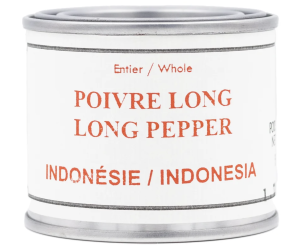Excerpt from Ari’s Top 5 enews
An inspiring spice from Indonesia

As many of you will already know, I have a deep devotion and great love for the terrific Tellicherry black pepper we get through our friends at Épices de Cru in Quebec. And while Tellicherry continues to take the top spot, I never forget that we have a wide range of other black peppers, each of which is also really wonderful in its own right. Right now, over the last month or two, long pepper has worked its way onto my regular culinary playlist. While it’s not well known in this part of the world, it is worthy of a whole lot more attention!
The plant itself is native to India, and our English word pepper originates with the name for long pepper in the Tamil language: pippali. Long pepper is referenced in ancient Ayurvedic texts for its medicinal properties. It arrived in Greece from Asia sometime in the fifth or sixth century B.C.E. Back in its day, long pepper was actually more popular with Roman cooks than the now standard black pepper, and it sold for about three times the price (and black pepper itself often was priced higher than gold). In the Middle Ages, long pepper passed out of use in Europe, likely because it’s slightly moister than black pepper and hence didn’t have the latter’s keeping qualities, and it’s pretty much been out of distribution in these parts until relatively recent times. Its scientific name is Piper longum for the long pepper that grows in India, or Piper retrofractum for the strain that comes from Java (the black peppercorns we’re familiar with are known as Piper nigrum). The Javanese strain is more intensely flavorful and, happily, that’s what we’re getting.
Long pepper is about an inch or so long, like a little series of little black “peppercorns” that merge together into a single “cone” as they grow. The flavor is clearly in the same family as what currently comes out of the pepper mill that’s permanently ensconced on my dining room table but with some seriously interesting high notes and a sweet, round fruitiness that’s really lovely. I keep trying to think of a good way to describe it. Where Tellicherrry black pepper’s flavor is a bit more direct with nice winy undertones, Épices de Cru’s Indonesian Long Pepper is more of a roller coaster ride, sort of an accordion full of exotic flavors that play out in twists and turns as you enjoy it. It makes for some very interesting, very spicy eating. Writing for the website Serious Eats a few years ago, Max Falkowitz shared,
Its flavor is much more complex than black pepper, reminiscent of spice blends like garam masala more than a single spice. It possesses black pepper’s heat and musk, but in a less harsh, more nuanced way, tempered by sweet notes of nutmeg, cinnamon, and cardamom. Its finish lingers on the tongue with a tobacco-like coolness; where black pepper stings, long pepper balms.
To use this spice, you can cut the “cones” into small pieces with a chef’s knife. A carefully applied hammer and a clean towel can work well to crush them. Or you can buy a nice spice mill to grind them as I do. You can use it any way you would black pepper. Get medieval and make a sweet-spicy dessert by poaching stem fruit in white wine, vanilla, a touch of sugar, and lots of long pepper. In India, it’s used for pickles, and in Ethiopia, for traditional meat stews and the spice mix berbere. Thai cooks use long pepper a lot in soups and stir-fries. I’ve used it in risotto, on pasta, or simply crushed and tossed onto a salad. This is also one of the “secret” spices in the very popular Gingerbread Cake we make at the Bakehouse in the colder months. It’s great sprinkled on the rounds of fresh goat cheese from the Creamery. Spice fresh fish with it or use it to make a steak “au poivre.”



